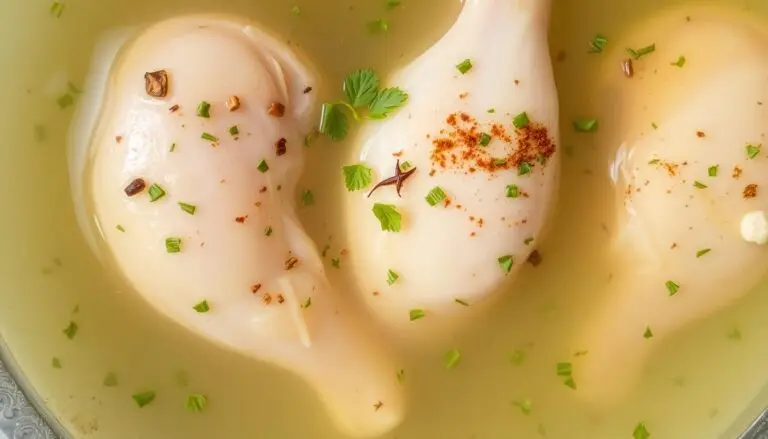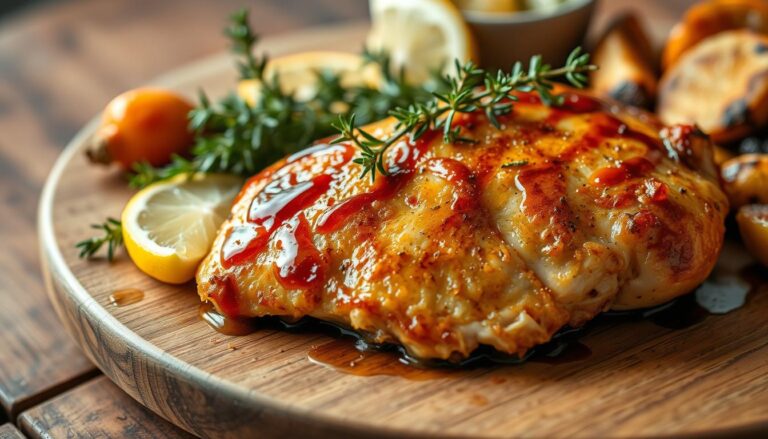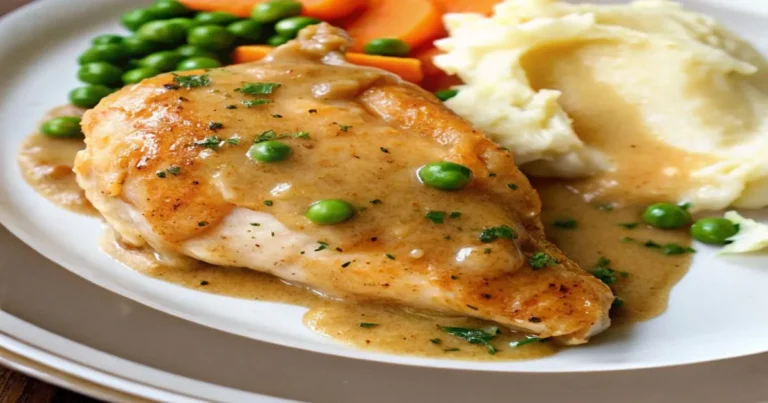How to Brine Chicken Breast for Maximum Flavor
Table of Contents
When cooking chicken breast, you want it to be juicy and full of flavor. Brining is a simple way to do this. It involves soaking the chicken in a mix of water, salt, and sometimes sugar and other flavorings before cooking. This method can greatly improve the taste and texture of your chicken.
To start brining, you need to know the basics. This includes the right mix of ingredients for your brine solution and how long to soak the chicken. With a bit of practice, you can make a delicious brine chicken recipe that will wow your family and friends.
Key Takeaways
- Brining chicken breast can help keep it juicy and flavorful
- A basic brine solution includes water, salt, and sometimes sugar and other flavorings
- Learning how to brine chicken breast is a simple process that can make a big difference in the taste and texture of your chicken
- A good brine chicken recipe can be customized with your favorite herbs and spices
- Brining is a great way to add flavor to chicken breast before cooking
Understanding the Science Behind Chicken Brining
Soaking chicken in a chicken brine solution uses osmosis to add flavor and moisture. This is key for tender and juicy chicken, especially in fried chicken brine recipes. The salt in the brine denatures chicken proteins, making them more open to flavors.
The science of chicken brining is quite interesting. It helps you see why this method is so good. By using a chicken brine solution, you can make the meat flavorful and moist. This is great for many dishes, including fried chicken brine recipes.
What Happens During the Brining Process
The chicken absorbs flavors from the brine through osmosis. The salt in the brine denatures chicken proteins. This makes the chicken more open to flavors, making it tender and juicy.
Why Brining Makes Chicken More Flavorful
Brining makes chicken more flavorful by letting it soak up brine flavors. The salt in the brine enhances the chicken’s natural taste. This makes the chicken more delicious and tender. Whether you’re making chicken brine or fried chicken brine recipes, brining is key for great taste and texture.
The Role of Salt in Moisture Retention
The salt in the brine is important for keeping moisture in. It denatures chicken proteins, locking in moisture. This makes the chicken tender and juicy. It’s especially important for fried chicken brine recipes, preventing dryness.
Understanding chicken brining’s science helps you see its benefits. It lets you make delicious and flavorful chicken dishes, like chicken brine and fried chicken brine recipes.
Essential Ingredients for a Perfect Chicken Brine
To make a tasty chicken brine, start with the basics. You’ll need water, salt, and sometimes sugar. These help make a brine that enhances the chicken’s flavor without being too strong. Feel free to add herbs and spices to make your brine unique.
Customizing your brine is all about finding the right mix. Add onions, garlic, and carrots for extra flavor. Remember to adjust the salt and sugar to your liking. A good starting point is 1 cup of kosher salt for every 1 gallon of water.
Here are some key ingredients to begin with:
- 1 gallon of water
- 1 cup of kosher salt
- 1/2 cup of brown sugar (optional)
- Aromatics like onions, garlic, and carrots
- Herbs and spices (such as thyme, rosemary, and black pepper)
Knowing the basic ingredients and flavorings lets you craft a brine that matches your taste. Try different mixes to discover the ideal flavor for your chicken.
| Ingredient | Quantity | Purpose |
|---|---|---|
| Water | 1 gallon | Base of the brine solution |
| Kosher salt | 1 cup | Helps to retain moisture and flavor |
| Brown sugar | 1/2 cup (optional) | Balances out the flavor of the salt |
Basic Chicken Breast Brine Recipe
Finding the right mix of flavors is key for a tasty brine chicken recipe. A basic brine for chicken breasts uses water, salt, and sometimes sugar. This combo keeps the chicken moist and adds flavor. For a smoked chicken brine, you can add smoky tastes like paprika or liquid smoke.
First, you need to pick between a wet brine and a dry brine. Both can make great chicken. Here’s what you should know:
- Wet brine: This method soaks the chicken in a liquid brine. It’s perfect for adding moisture and flavor.
- Dry brine: This method uses a dry rub on the chicken. It adds flavor and texture.
Choosing the right brine chicken recipe is important. With some trial and error, you can make a mouthwatering smoked chicken brine. It’s sure to wow your guests.
How to Brine Chicken Breast: Step-by-Step Guide
To learn how to brine chicken breast, you need to know the basic steps. Brining chicken breast is easy and makes a big difference in taste and texture. The secret is to make a brine solution that’s just right.
Here’s a step-by-step guide to help you get started:
- Prepare your brine solution by mixing water, salt, and any desired flavorings, such as herbs and spices.
- Submerge the chicken breast in the brine solution, making sure it’s fully covered.
- Refrigerate the chicken for the recommended amount of time, usually several hours or overnight.
- Remove the chicken from the brine and cook it using your preferred method, such as grilling, baking, or sautéing.
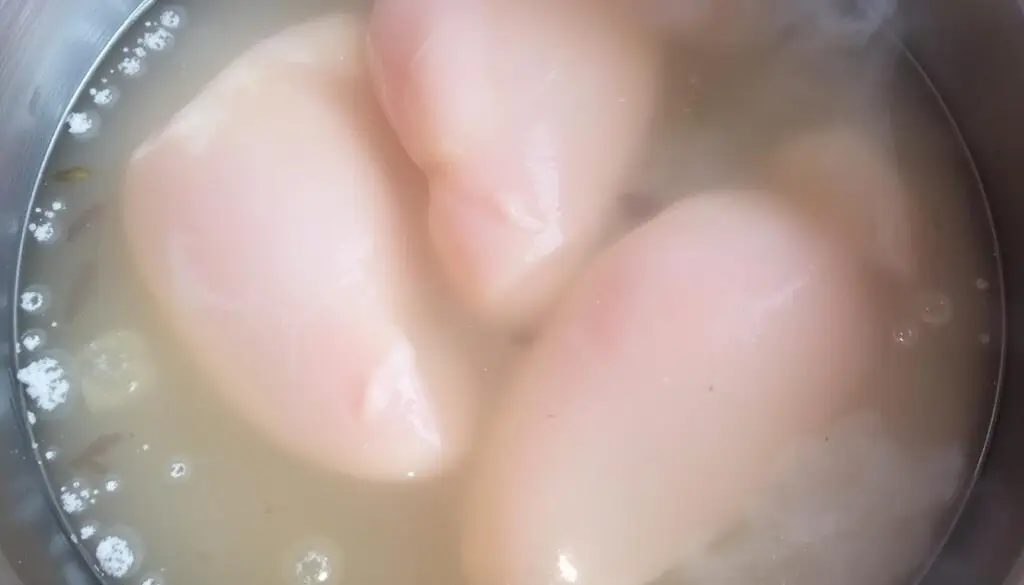
By following these steps, you’ll make delicious, flavorful chicken breast. Always use fresh ingredients and handle the chicken safely.
With practice, you’ll get better at how to brine chicken breast. You can try different flavors and techniques to make your own recipes.
| Brine Solution Ingredients | Quantity |
|---|---|
| Water | 1 gallon |
| Salt | 1 cup |
| Sugar | 1/2 cup |
| Herbs and spices | optional |
Flavoring Your Brine: Herbs and Spices
Creating a tasty chicken brine recipe is all about exploring. You can mix and match herbs and spices to find the perfect flavor for your chicken. For fried chicken, try adding paprika, garlic powder, and onion powder for a crispy taste.
Think about the flavor you want for your brine. Do you like Mediterranean with oregano and lemon, or Asian with ginger and soy sauce? You can choose any flavor you like. Here are a few ideas to start:
- Mediterranean-style: oregano, thyme, lemon, and garlic
- Asian-inspired: ginger, soy sauce, sesame oil, and chili flakes
- Classic American: paprika, garlic powder, onion powder, and black pepper
Creating a great brine recipe is all about trying new things. Don’t hesitate to mix different herbs and spices. Adjust the amounts to your liking. With practice, you’ll make amazing fried chicken brine and more.
By trying different flavors, you can make many tasty chicken brine recipes. These will impress your family and friends. So, be creative and start making delicious chicken dishes!
| Brine Style | Herbs and Spices |
|---|---|
| Mediterranean | oregano, thyme, lemon, garlic |
| Asian-inspired | ginger, soy sauce, sesame oil, chili flakes |
| Classic American | paprika, garlic powder, onion powder, black pepper |
Common Brining Mistakes to Avoid
When making a brine chicken recipe, it’s key to avoid common mistakes. You want your chicken to be both flavorful and moist. To get this right, you need to know the common errors that can mess up your brine chicken recipe.
Some common mistakes include using the wrong salt, not keeping the brine at the right temperature, and not watching the brining time. These errors can make your chicken taste too salty or not salty enough. To steer clear of these issues, stick to a proven brine chicken recipe and pay close attention to the details.
Here are some tips to help you avoid common brining mistakes:
- Use the right type of salt: Kosher salt or sea salt is best for brine chicken recipe because they don’t dissolve too fast.
- Control the temperature: Keep the brine between 36°F and 40°F to stop bacteria from growing.
- Monitor the brining time: Check the chicken often to avoid over-brining, which can make it too salty or mushy.
By following these tips and using a trusted brine chicken recipe, you can make sure your chicken is tasty, moist, and delicious. Always remember to keep food safety in mind and handle the chicken carefully to prevent contamination.
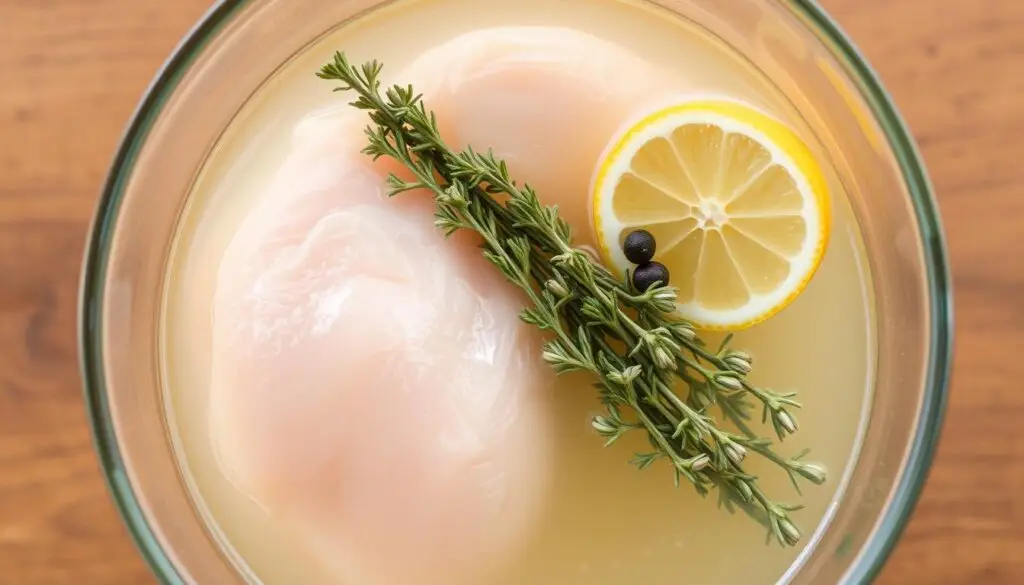
Specialized Brining Techniques for Different Cooking Methods
Brining chicken can vary based on your cooking method. For grilling, a shorter brine time is best to avoid too much salt. Smoking chicken, however, needs a longer brine to soak flavors deeper into the meat, making it a smoked chicken brine.
Fried chicken brine also needs special care. A brine rich in salt and sugar is key for a crispy outside and juicy inside. Here are some tips:
- For grilling, use a shorter brining time of 30 minutes to 1 hour
- For smoking, use a longer brining time of 2-3 hours
- For frying, use a brine that’s high in salt and sugar
By using these techniques, you can get the perfect taste and texture for your chicken. Whether you prefer smoked chicken brine or fried chicken brine, with practice, you’ll make dishes that wow everyone.
Safety Tips and Food Handling During Brining
Learning how to brine chicken breast means keeping safety and food handling top of mind. This way, your brined chicken will not only taste great but also be safe to eat. Always handle raw chicken with clean hands and tools. Make sure to wash your hands well after touching the chicken.
It’s key to cook your chicken to a safe temperature. The chicken should be cooked to at least 165°F (74°C). Use a food thermometer to check the chicken’s internal temperature. Also, refrigerate your brined chicken at 40°F (4°C) or below to stop bacteria from growing.
Here are some more safety tips for brining chicken breast:
- Always use a clean and sanitized environment for brining and cooking.
- Label and date your brined chicken to ensure you use the oldest ones first.
- Never leave your brined chicken at room temperature for an extended period.
By following these simple safety tips and guidelines, you can enjoy your delicious and flavorful brined chicken breast. You’ll know you’ve taken the right steps to ensure food safety. Remember, brining chicken breast is not just about the recipe. It’s also about handling and cooking your chicken safely.
Brining chicken breast is an art that requires attention to detail, patience, and a commitment to safety and quality.
To further emphasize the importance of safety, consider the following table:
| Step | Safety Tip |
|---|---|
| Handling Raw Chicken | Wash hands thoroughly after handling raw chicken |
| Brining | Use a clean and sanitized environment |
| Cooking | Cook to an internal temperature of at least 165°F (74°C) |
Storage and Make-Ahead Brine Solutions
Storing brined chicken safely is key to avoid contamination and spoilage. You can keep it in the fridge for up to 24 hours before cooking. Make sure it’s in a covered container and the fridge is at 40°F (4°C) or below.
To prep a brine chicken recipe ahead, make the brine solution and store it for up to 3 days. This lets you have a ready brine solution whenever you want. Just mix the ingredients like salt, sugar, and aromatics in a bowl until they dissolve.
- Always use a clean and sanitized container to store your brine solution.
- Label the container with the date and contents, so you can easily keep track of how long it’s been stored.
- Keep the brine solution refrigerated at a consistent temperature of 40°F (4°C) or below.
By following these tips, you can enjoy a tasty chicken brine recipe safely and conveniently.
| Brine Solution | Storage Time | Storage Temperature |
|---|---|---|
| Chicken Brine | Up to 3 days | 40°F (4°C) or below |
| Brined Chicken | Up to 24 hours | 40°F (4°C) or below |
Troubleshooting Your Brined Chicken
Learning to brine chicken breast can sometimes lead to a few hitches. To make sure your chicken is always tasty, let’s tackle some common problems and their fixes. If your chicken tastes uneven, double-check your brine recipe. Make sure you’re using the right amount of salt and sugar.
Identifying the problem’s source is crucial. Here are some common issues and how to fix them:
- Over-salting: Cut down the salt in your brine or try a dry brine instead.
- Under-cooking: Always check the chicken’s internal temperature with a meat thermometer.
- Uneven flavor distribution: Make sure to massage the meat and turn it regularly while it’s brining.
By following these tips and using a balanced brine recipe, you’ll make delicious chicken every time. Always remember to handle raw poultry safely. With practice and patience, you’ll master brining chicken breast and solve any problems that come up.
For more on chicken brining and recipes, see our other articles and resources. With the right techniques and ingredients, you’ll make dishes that wow everyone.
| Common Issues | Solutions |
|---|---|
| Over-salting | Reduce salt in recipe or try dry brine |
| Under-cooking | Use meat thermometer |
| Uneven flavor distribution | Massage meat and turn regularly |
Conclusion: Mastering the Art of Chicken Brining
Learning to brine chicken is a journey that requires patience and a spirit of adventure. This guide has given you the tools to become a pro at brine chicken. Your grilled, smoked, or fried chicken will be so good, it will wow everyone.
Success in brining comes from knowing the science and tweaking it to your liking. Feel free to mix up flavors or change the brine to suit your taste. Soon, you’ll have a unique smoked chicken brine that makes your meals unforgettable.
The real joy of brining is the thrill of making chicken that’s both tasty and tender. Enjoy the process, have fun, and relish the tasty outcomes of your cooking experiments. Happy brining!
FAQ
What is the purpose of brining chicken breast?
What are the essential ingredients for a chicken brine?
How long should I brine chicken breast?
How do I avoid common brining mistakes?
Can I use different cooking methods with brined chicken?
How do I store brined chicken and brine solution?
What should I do if my brined chicken doesn’t turn out as expected?
Have you given our recipe a try?
There are no reviews yet. Be the first one to write one.



